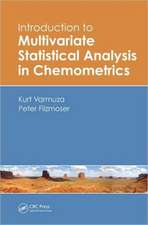Applications of Supercritical Fluids in Industrial Analysis
Autor J.R. Deanen Limba Engleză Paperback – 3 oct 2013
Preț: 382.42 lei
Nou
Puncte Express: 574
Preț estimativ în valută:
73.24€ • 75.46$ • 61.35£
73.24€ • 75.46$ • 61.35£
Carte tipărită la comandă
Livrare economică 25 februarie-11 martie
Preluare comenzi: 021 569.72.76
Specificații
ISBN-13: 9789401049511
ISBN-10: 9401049513
Pagini: 244
Ilustrații: XIV, 224 p.
Dimensiuni: 155 x 235 x 13 mm
Greutate: 0.35 kg
Ediția:Softcover reprint of the original 1st ed. 1993
Editura: SPRINGER NETHERLANDS
Colecția Springer
Locul publicării:Dordrecht, Netherlands
ISBN-10: 9401049513
Pagini: 244
Ilustrații: XIV, 224 p.
Dimensiuni: 155 x 235 x 13 mm
Greutate: 0.35 kg
Ediția:Softcover reprint of the original 1st ed. 1993
Editura: SPRINGER NETHERLANDS
Colecția Springer
Locul publicării:Dordrecht, Netherlands
Public țintă
ResearchCuprins
1 Properties of supercritical fluids.- 1.1 Introduction.- 1.2 Fundamental studies of supercritical fluids.- 1.3 Choice of supercritical fluid for extraction.- 1.4 Prediction of solubility.- References.- 2 Instrumentation for supercritical fluid chromatography.- 2.1 The anatomy of a supercritical fluid chromatograph.- 2.2 The quality of the fluids.- 2.3 The pumps.- 2.4 Sample introduction.- 2.5 Columns.- 2.6 Restrictors.- 2.7 Detectors.- References.- 3 Instrumentation for supercritical fluid extraction.- 3.1 Introduction.- 3.2 SFE instrumentation.- 3.3 Depressurization systems.- 3.4 Collection of extracts.- 3.5 Method development.- 3.6 Conclusions.- References.- 4 Supercritical fluid chromatography and extraction of pharmaceuticals.- 4.1 Introduction.- 4.2 SFC of pharmaceuticals.- 4.3 Drugs of abuse.- 4.4 Supercritical fluid extraction.- 4.5 Conclusions.- References.- 5 Applications of supercritical fluids in polymer analysis.- 5.1 Introduction.- 5.2 Supercritical fluid chromatography.- 5.3 Applications of SFC for polymers.- 5.4 Supercritical fluid extraction.- 5.5 Applications of on-line extraction.- 5.6 Applications of off-line extraction.- 5.7 Conclusions.- References.- 6 Applications of supercritical fluids in food science.- 6.1 Chemical derivatization.- 6.2 Solid-phase extraction.- 6.3 Multidimensional chromatography.- 6.4 Drug and chemical residues.- 6.5 Vitamins.- 6.6 Lipids.- 6.7 Colours.- 6.8 Sugars.- 6.9 Waxes.- 6.10 Flavours and aromas.- Acknowledgements.- References.- 7 Supercritical fluid extraction in environmental analysis.- 7.1 Introduction.- 7.2 Practice.- 7.3 Factors affecting extraction from environmental samples.- 7.4 On-line coupling of SFE to chromatographic analysis.- 7.5 Applications.- References.- 8 Future developments in analytical supercriticalfluid technology: some ideas from recent research.- 8.1 Introduction.- 8.2 Theory and understanding.- 8.3 Instrumentation.- 8.4 Special techniques.- Acknowledgements.- References.- General index.- Index of compounds.
Recenzii
...well organized and edited and can be recommended to those who want to apply SFC/SFE in their work. - Trends in Analytical Chemistry.; In conclusion, the book makes a useful contribution in transfering supercritical fluid methods from a basic study area to an application that solves real problems. - Chemistry in Britain



